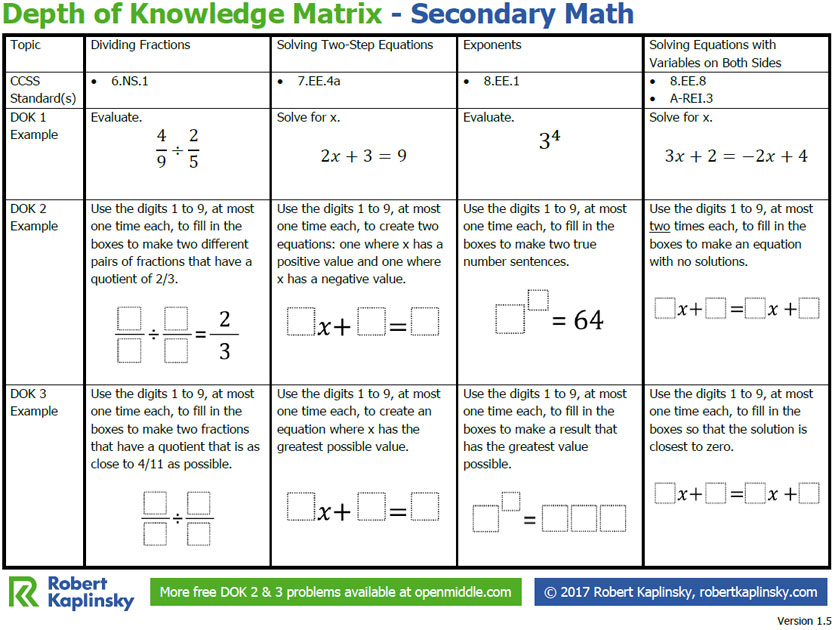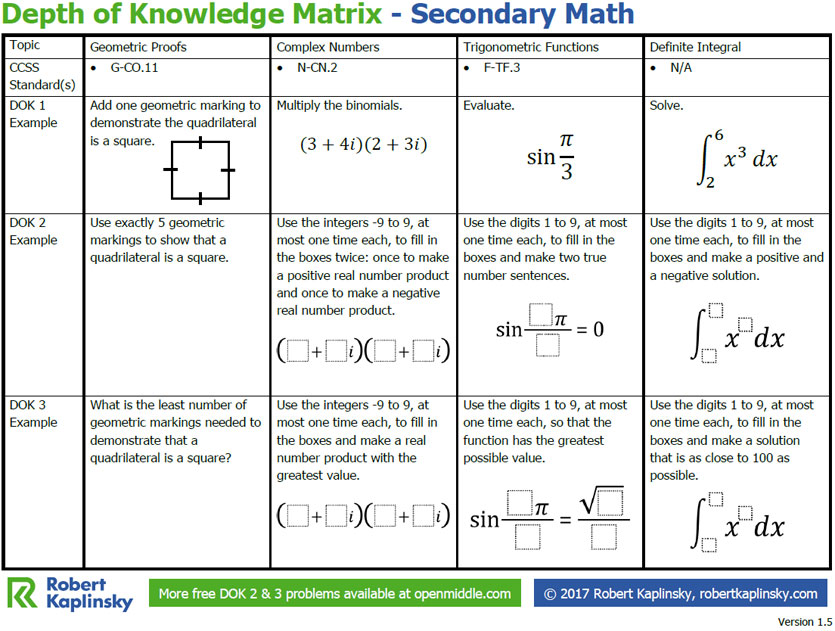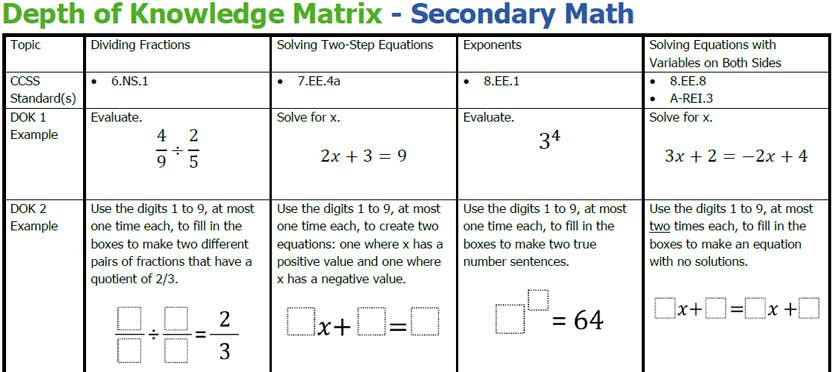Last week I posted my first attempt to expand upon my previous Depth of Knowledge Matrix that helped make it easier to distinguish between depth of knowledge levels in mathematics. This week I am releasing the secondary mathematics matrix to go with last week’s elementary mathematics matrix.
The pictures below give you a preview of what each page of the matrix covers. There are eight topics covering sixth, seventh, and eighth grade, Algebra I, Geometry, and Algebra II (or Integrated Math I to III), as well as Trigonometry and Calculus. You can download and share a high resolution printable version by clicking the “Download PDF” button at the bottom of the page.


It is highly unlikely that there are no issues with this matrix, so please let me know if you have any questions, concerns, or comments by leaving me a message below. Also, if you’re wondering about where Depth of Knowledge level 4 is, those are usually represented by performance tasks or problem based lessons like the ones I have here. They don’t fit neatly into a matrix like this, so I haven’t included them.
Note that these problems focus on the depth of knowledge for the math content, not the conversation. None of these problems ask students to explain themselves, but all of them require increasing depth of math content knowledge to solve. You could easily incorporate some “Why?” and “How?” questions to make a more rigorous conversation.
If you like these problems and want to find more DOK 2 and DOK 3 problems, check out openmiddle.com. Open Middle is a collaborative website where all problems are free and new submissions are welcome. The more problems people submit, the more problems we all have access to. It was co-founded by Nanette Johnson and I with help from Bryan Anderson, Daniel Luevanos, and Zack Miller.


I’m not able to download this PDF – its great and want to share it with my teachers. How can I do this?
I’m not sure where in the process you are not able to download it. Assuming you are entering your information, it should send you an email. If you are not receiving the email, try using a different email address like you personal address. Sometimes school districts block my emails.
Assuming you are receiving the emails, there should be two links in the email: one for a PDF and one for a zipped version of the file. If you are having trouble downloading it on a phone, try using a laptop or desktop computer.
If it is neither of those, please let me know. I can see that hundreds of people have successfully downloaded it so I hope you will be able to as well.
I find these so helpful, especially because you have provided a range of examples of the same standard being increased. I have shared these with teachers at my school, and I am planning on using these in a PD workshop I am applying to lead on Active Learning. We hear so much about breadth and depth, and I have been thinking a lot about how to go deeper in the subjects. This gives me a clear path and I’m excited about using these. I actually used an open middle problem last school year on a test as a challenge problem and was amazed at how few could actually do it.
Thanks for the kind words Sharee. As you probably realize, I’ve got two other version of these matrices: one for elementary (Kindergarten to 5th) and one for elementary and secondary (1st to Algebra 2).
Oh, thanks for the reminder! I already had the 2 separate but the combined one is definitely useful as well.
By the way, do you ever travel internationally for workshops?
Hi Sharee. So far I’ve only done work in the US and Canada but I’m open to the idea. Send me an email at [email protected] and we can talk about it more.
Love the idea of a DOK matrix and I will definitely use as I work with teachers. I think it will be a great example and conversation starter as teachers think about increasing the cognitive demand of the mathematical tasks they use. Not that it really matters, because I think the power is in getting teachers to think this way, but isn’t your 7th grade example more geared toward the 6th grade standard? Other than including negative #s on the DOK2 level, the other language in the problem seems to be aligned to 6th grade. Should I rewrite with a multi-step equation or am I misinterpreting the standard?
Hmm. I really can’t recall what I was thinking. That standard clearly references two-step equations (Solve word problems leading to equations of the form px + q = r and p(x + q) = r, where p, q, and r are specific rational numbers.)
Clearly this column will need to change. You’re the first person to bring this to my attention, so thank you very much. There are plenty of 2-step equation problems over on Open Middle (http://www.openmiddle.com/?s=two+step) so I will likely pull from there. Again, thanks for this. I’ll revise it in the coming weeks.
It’s updated now Michael. Thanks!
I have filled in the fields, and also cannot download the file.
Hi Anne Marie. When you enter your email address, it should email you a link. If you didn’t get the email, try using a non-work email address as sometimes they get blocked.
Wow, this is power full to see the math DOK matrix and follow the progression. Thanks for the time and effort it took to produce such a quality instrument.
Whe teachers are given a little we are always want more….do you see yourself completing this for all the common core standards? I think the benefit of seeing the DOK for each standard (example: 6-8) would really help as others ponder curriculum and curriculum sequence as well as rigor.
I really would love to see this completed 6-8 for more standards…… thanks!!!
Hi Lesa. I’d love to have these for all standards, but truly they are challenging to make. I’ll keep this in mind when planning. Thanks for the suggestion.
Thank you! I like how it is organized and easy to compare the progression. This will be useful for our PLC discussions.
Great. Good luck with sharing it Linda.
I love how you expanded the DOK Matrix to upper division HS math. I be sure to share with my colleagues. Thanks for the awesome work!
Thanks friend. Glad you like it.
Thank you, Robert!
Before I attempt to make my own version, do you have a DOK document aligned to the TEKS?
Thanks!
Denise
Unfortunately I don’t. Are the standards that different?
No, they aren’t much different but I thought I would check before I spend the time adjusting. Appreciate the prompt reply! These resources are really useful! Thank you for sharing!
Excellent examples of problems that can help to increase the critical thinking skills of our students